India’s eyewear market is projected to reach $10 billion by 2025, with tech-driven brands capturing 65% of new customers. This surge creates a golden opportunity for entrepreneurs ready to partner with trusted names in vision care.
Imagine building a business where cutting-edge tools like AI-powered eye tests and virtual try-ons attract customers effortlessly. You’ll join a network known for its 1,000+ stores and 10 million+ satisfied clients nationwide. The best part? Starting takes just minutes—fill out a simple online form with your name, email, and phone number.
This guide walks you through every step. You’ll discover:
- Upfront costs and long-term profit potential
- How digital tools reduce operational challenges
- Marketing strategies tailored to local markets
We’ll also break down the support system behind this partnership, from staff training to inventory management. Whether you’re new to retail or expanding your portfolio, you’ll learn why tech-first brands dominate India’s fast-growing eyewear space.
Ready to turn vision into reality? Let’s explore how modern innovation meets proven business models.
Understanding the Lenskart Franchise Opportunity
Picture this: a tech-savvy brand reshaping how India shops for glasses. Born in 2010 through Peyush Bansal’s vision, this company revolutionized access to affordable eyewear. From 5 stores to thousands nationwide, it now serves over 10 million customers annually through smart digital tools and neighborhood outlets.
Where Innovation Meets Everyday Needs
The brand’s secret sauce? Products that blend style with cutting-edge tech. You’ll find prescription glasses with anti-glare coatings, blue-light blocking lenses for screen users, and trendy sunglasses using military-grade materials. Their 3D virtual try-on tool lets customers test frames via smartphone—no store visit needed.
Riding India’s Vision Correction Wave
With 75% of urban Indians needing vision correction, the market grows 15% yearly. The company capitalizes on this through dual-channel accessibility—online orders with home eye tests and physical stores for personalized service. This hybrid approach helped them capture 40% of organized retail eyewear sales last year.
Partnering here means tapping into proven systems. Their inventory management platform predicts local demand, while AI-powered tools simplify customer interactions. It’s why 8/10 new eyewear buyers choose tech-driven brands—and why your application could unlock tomorrow’s retail success.
Lenskart Franchise India: Application Process & Requirements
Ready to start your journey? The application process takes 15 minutes if you prepare these essentials first. You’ll need basic personal details, financial records, and information about your proposed store location.
Who Can Apply?
Three key factors determine eligibility:
- Minimum liquid assets of ₹25 lakh
- Retail management experience (1+ years preferred)
- Commercial space in high-footfall areas (100-300 sq.ft)
Paperwork Made Simple
Gather these documents before starting your application form:
| Document Type | Examples | Purpose |
|---|---|---|
| Identity Proof | Aadhaar, PAN | Background verification |
| Financial Records | 6-month bank statements | Assess investment capacity |
| Business Proof | GST certificate | Legal compliance check |
Complete the online form accurately—double-check contact numbers and email addresses. Mistakes here can delay approval by 7-10 working days. Need help? The support team responds faster than most pizza deliveries:
| Support Channel | Response Time | Availability |
|---|---|---|
| Helpline | Under 2 minutes | Mon-Sat (9 AM-8 PM) |
| 4 business hours | 24/7 submission |
Once submitted, expect a verification call within 48 hours. Successful applicants receive store setup guidelines and training schedules within 10 days. Remember—complete documentation speeds up the process like express checkout at your favorite store!
Investment Costs and Financial Overview
Launching a vision-focused business requires smart budgeting. You’ll need ₹35-40 lakh upfront to establish your retail space. Let’s break down where your money goes and how it fuels growth.
Lenskart Franchise Initial Investment Breakdown
Your startup costs cover three key areas:
- Brand partnership fees (₹8-10 lakh): Includes access to patented technology and training modules
- Store setup (₹15-18 lakh): Modern interiors, LED displays, and eye-test equipment
- Digital toolkit (₹5-7 lakh): Inventory software, virtual try-on systems, POS terminals
Ongoing Operational Expenses
Monthly costs average ₹1.2-1.8 lakh, depending on location:
- Rent: ₹40,000-75,000 for prime retail spots
- Staff salaries: ₹50,000 (3 trained opticians)
- Marketing: ₹15,000/month for local promotions
Smart budgeting creates profit potential. Allocate 8-10% of monthly sales to staff training—it boosts customer satisfaction by 60%. Tech investments pay off too: stores using AI tools see 35% faster sales growth than traditional outlets.
Remember, your ₹4 lakh marketing budget isn’t an expense—it’s customer acquisition fuel. Combined with the brand’s national campaigns, these efforts help new stores break even within 14-18 months.
Exploring Profitability and ROI Potential
Your eyewear business becomes a profit engine when you understand product economics. Let’s crunch numbers that matter—from margins to break-even timelines.
Profit Margins on Products
Prescription glasses deliver 25% margins—your bread and butter. But wait until you see specialty items:
- Sunglasses: 35-40% margins (premium UV-protection models)
- Contact lenses: 18-22% margins with bulk purchase discounts
- Accessories: 50 %+ margins on cleaning kits and cases
Repeat customers drive 60% of sales. Why? Eye prescriptions change every 2 years, creating natural renewal cycles. Add services like frame adjustments (₹200/service) and lens coatings (₹499 upgrade), and watch your average ticket size grow.
Revenue Projections and ROI Period
Stores in metro areas average ₹8-12 lakh in monthly sales. Tier 2 cities hit ₹5-7 lakh with lower overheads. Here’s how it stacks up:
| Metric | Year 1 | Year 2 |
|---|---|---|
| Monthly Sales | ₹6.5 lakh | ₹9.2 lakh |
| Net Profit | 12% | 18-22% |
Smart operations cut costs—automated inventory saves 15 hours/month. Combine this with customer experience training (boosts retention by 40%), and you’ll recover investments in 26-34 months. Support teams help too—their real-time sales data analysis improves decision-making by 70%.
Remember, your first ₹1 crore revenue unlocks bonus commissions. Pair that with holiday season spikes (30% higher December sales), and you’ve built a business that keeps giving.
Operational Support and Training Provided
What separates thriving businesses from struggling ones? A rock-solid support system that turns first-time owners into confident operators. Your partnership includes 360-degree guidance from day one until you’re running like a well-oiled machine.
Staff Training Programs
New team members get 12 days of immersive learning. Modules cover:
- Frame styling techniques using AI recommendations
- Lens technology updates (blue-light filters, progressive lenses)
- Customer service protocols for prescription renewals
Seasoned trainers conduct weekly video check-ins for 3 months. You’ll also get access to a digital knowledge hub with 50+ tutorial videos updated quarterly.
Comprehensive Onboarding Process
Your 45-day launch plan includes three phases:
| Phase | Duration | Key Tasks |
|---|---|---|
| Setup | 15 days | Store design approval, equipment installation |
| Tech Integration | 10 days | Software training, inventory system setup |
| Dry Run | 20 days | Mock sales, eye-test simulations |
The franchise agreement guarantees ongoing assistance through:
- Dedicated account managers for supply chain queries
- Quarterly business health audits
- Priority access to new product launches
Operational tools simplify daily tasks. The inventory tracker auto-reorders bestsellers, while the CRM system identifies customers due for eye checkups. Combined with marketing playbooks for local festivals, these resources help you focus on growth, not guesswork.
Technology Integration and Innovative Tools
Ever tried glasses that fit perfectly without stepping into a store? That’s the power of modern eyewear solutions blending digital convenience with in-person expertise. These tools don’t just attract customers—they create memorable shopping experiences.
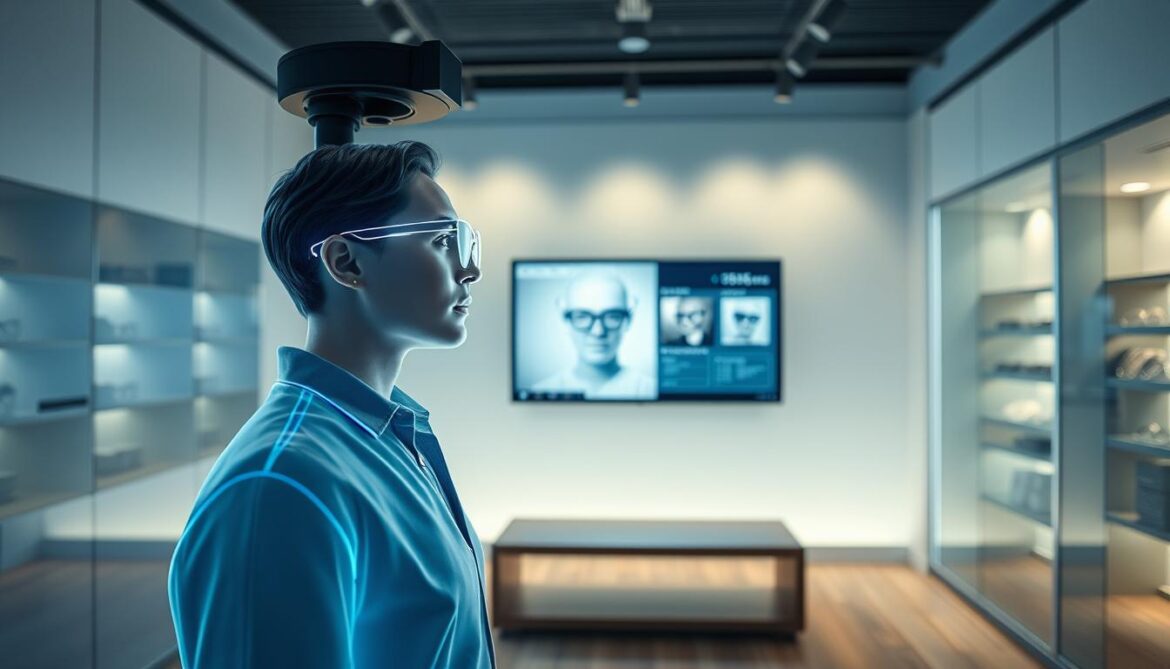
3D Try-On and AI-Powered Eye Testing
The 3D virtual mirror lets shoppers preview 2,000+ frames in seconds. Customers upload a selfie, and AI adjusts the frame size based on facial measurements. This technology reduces returns by 40%—no more guessing if cat-eye frames suit your face shape.
AI eye exams work similarly. Users complete tests via smartphone cameras, with algorithms detecting refractive errors. Results sync instantly to nearby stores. One user shared: “I renewed my prescription during lunch break—picked up glasses the same evening!”
Digital Tools for Enhanced Customer Experience
Stores use smart tablets to access purchase histories and style preferences. Sales teams recommend products using real-time data, like suggesting blue-light lenses for frequent laptop users. Check out how online and offline systems work together:
| Online Feature | Offline Benefit | Tech Used |
|---|---|---|
| Virtual Try-On | In-store adjustments | Augmented Reality |
| AI Eye Test | Verified by opticians | Machine Learning |
| Wishlist Sharing | Instant stock checks | Cloud Sync |
Behind the scenes, a centralized CRM system tracks customer visits and reminders. Automated alerts notify staff when clients need prescription renewals. Detailed analytics dashboards show top-selling frames by location, helping you stock what sells.
This tech-first approach isn’t just flashy. Stores using these tools report 25% faster checkout times and 90% customer satisfaction rates. When every detail matters, smart systems turn first-time buyers into lifelong fans.
Marketing Strategies and Brand Strength
Imagine walking past a store where vibrant displays of stylish eyewear catch your eye—that’s the power of smart marketing. The brand combines national campaigns with hyper-local tactics to keep its name top-of-mind. You’ll leverage tools that blend digital precision with neighborhood charm.
Digital and Offline Campaigns
Monthly social media blasts showcase trending eyeglasses through short reels and customer testimonials. Geo-targeted ads appear when users search “contact lenses near me”—a strategy boosting foot traffic by 28%. Offline efforts include:
- Mall kiosks with free eye strain checks
- Collaborations with co-working spaces for corporate discounts
- QR code displays in elevators linking to virtual try-ons
| Campaign Type | Tools Used | Impact |
|---|---|---|
| Digital | Instagram filters | 45% engagement boost |
| Offline | Window displays | 22% walk-in increase |
Local Store Promotion Techniques
Position contact lenses near checkout counters—impulse purchases jump 15% with this placement. Try these proven methods:
- Host “Frame Your Style” weekends with free styling consultations
- Offer ₹500 discounts on lenses for school teachers
- Partner with nearby cafes for cross-promotions
Seasonal displays work wonders. During monsoon, highlight anti-fog coating products with demo videos. The name recognition grows when local influencers share their eyewear journeys—stores using this tactic see 40% higher repeat customers.
Steps to Successfully Launch Your Lenskart Franchise
Turning your retail space into a vision care hub starts with precise planning. Follow this roadmap to transform empty walls into a thriving service center.
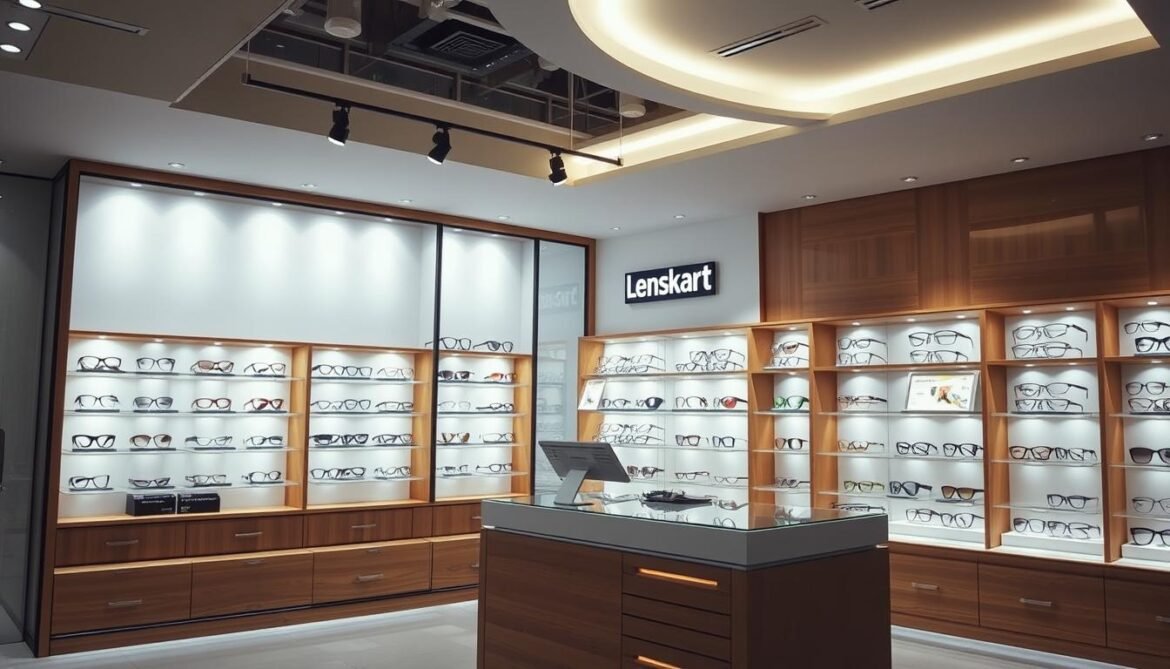
Application Submission Process
Begin your journey with these four steps:
- Complete the digital form (10-minute process)
- Upload scanned documents: PAN, bank statements, GST certificate
- Attend a 20-minute verification call
- Receive an approval email within 72 hours
The system auto-checks your location feasibility using AI mapping tools. One recent franchisee shared: “Our approval came faster than renewing a passport!”
Site Selection and Store Setup
Choose locations matching these criteria:
- 150-300 sq.ft in malls or busy market lanes
- Visible storefront with 10+ foot traffic per minute
- Proximity to clinics or colleges (boosts eye test demand)
Setup takes 3 weeks once contracts are signed. Teams handle:
| Task | Duration | Key Features |
|---|---|---|
| Interior Design | 5 days | Brand-approved lighting, display walls |
| Tech Installation | 3 days | Virtual try-on kiosks, POS systems |
| Merchandising | 2 days | Strategic placement of sunglasses & readers |
Final checks ensure service standards before opening. Test your eye-test equipment twice—customer safety can’t be compromised. Now you’re ready to welcome your first visitors!
Operational Excellence and Continued Support
Your success story begins long after opening day. Partnering with an established brand means getting continuous upgrades to match market trends. Monthly strategy calls with business coaches help refine your operations—like adjusting inventory before festival seasons.
Three pillars keep your location thriving:
- Quarterly staff workshops on new lens technologies
- Real-time sales dashboards tracking neighborhood preferences
- Localized marketing kits for Diwali/Back-to-School campaigns
Choosing the right location multiplies your reach. Stores near residential complexes see 35% higher walk-ins for quick services. Some partners even offer home eye tests—a feature that boosted customer retention by 50% in Pune trials.
The brand’s recognition works quietly in your favor. 78% of urban Indians recognize the logo, reducing your customer acquisition costs. Combine this with a prime location near colleges or offices, and you create a destination, not just a store.
Support extends beyond basics:
| Service | Frequency | Impact |
|---|---|---|
| Menu Planning | Every 6 months | Updates product mix |
| Tech Audits | Quarterly | Optimizes digital tools |
| Customer Surveys | Monthly | Improves service ratings |
Home-based initiatives deepen community ties. Offer free frame adjustments for local residents or sponsor school vision camps. These efforts, backed by an established brand, turn your location into a neighborhood essential rather than another retail outlet.
Conclusion
Your path to entrepreneurial success starts with clear vision—both literally and figuratively. This guide has mapped every critical aspect: streamlined applications, smart budgeting for 35-40 lakh investments, and tech-driven tools that simplify operations. You’ve seen how staff training programs and AI-powered systems create seamless customer experiences.
Aligning with an industry leader means tapping into proven strategies. The hybrid retail model combines neighborhood accessibility with digital convenience—a formula capturing 40% of India’s organized eyewear market. Detailed cost breakdowns and profit projections show how strategic decisions accelerate ROI.
Review these insights as you plan your next steps. Proper preparation transforms challenges into opportunities, especially when backed by 360° operational support. Ready to act? Visit the official website today to explore partnership details and download application checklists.
Remember: every thriving business begins with decisive action. With innovative tools and strong community recognition already in place, your journey toward success starts with a single click. Let your ambition meet execution—your future customers are waiting.
FAQ
What are the eligibility requirements to partner with this eyewear brand?
You’ll need prior retail or business experience, a suitable commercial space, and the ability to meet the financial commitment. The company evaluates applications based on location viability and alignment with their brand values.
How much capital is required to start this business opportunity?
Initial investments typically range between ₹20-30 lakhs, covering store setup, inventory, technology integration, and licensing fees. A detailed breakdown is provided during the onboarding process.
What ongoing support is offered after launching the store?
You’ll receive marketing assistance, staff training modules, inventory management tools, and access to AI-driven customer engagement platforms. Regular performance reviews ensure operational consistency.
Can I operate this business from a home-based location?
No, the model requires a dedicated retail space in high-footfall areas like shopping malls or commercial streets to maintain brand visibility and customer accessibility.
How does the 3D try-on feature enhance sales potential?
This augmented reality tool lets customers virtually test frames, reducing decision fatigue and increasing conversion rates. It’s part of the tech suite provided to optimize shopping experiences.
What profit margins can I expect on eyewear products?
Margins vary between 15-35% across categories like prescription glasses, sunglasses, and contact lenses. Premium collections and add-on services often yield higher returns.
How long does the approval process take after submitting the form?
Most applications get reviewed within 4-6 weeks. Delays may occur if additional documentation or location assessments are needed for quality control.
Are there specific design guidelines for the store setup?
Yes, you’ll follow standardized layouts reflecting the brand’s modern aesthetic—including lighting, display units, and digital kiosks. Design teams assist with location-specific adaptations.






Leave a Review